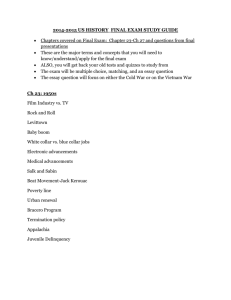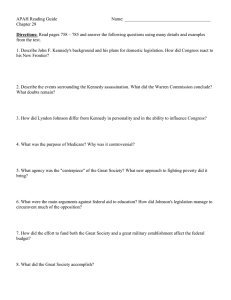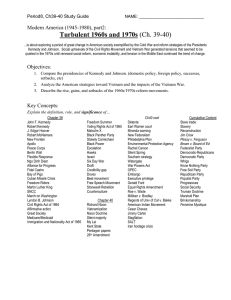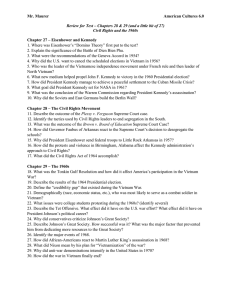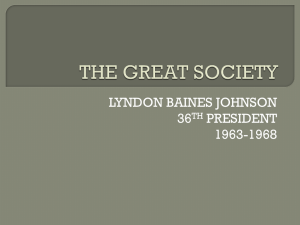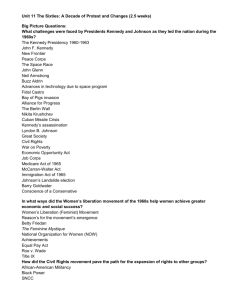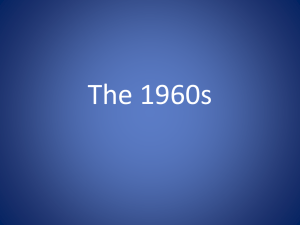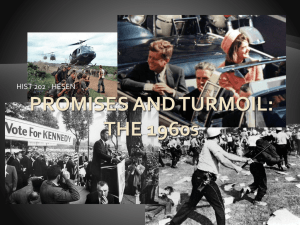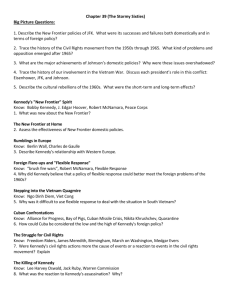Chapter 38: “The Stormy Sixties” 1960 – 1968: Kennedy and Johnson I.
advertisement
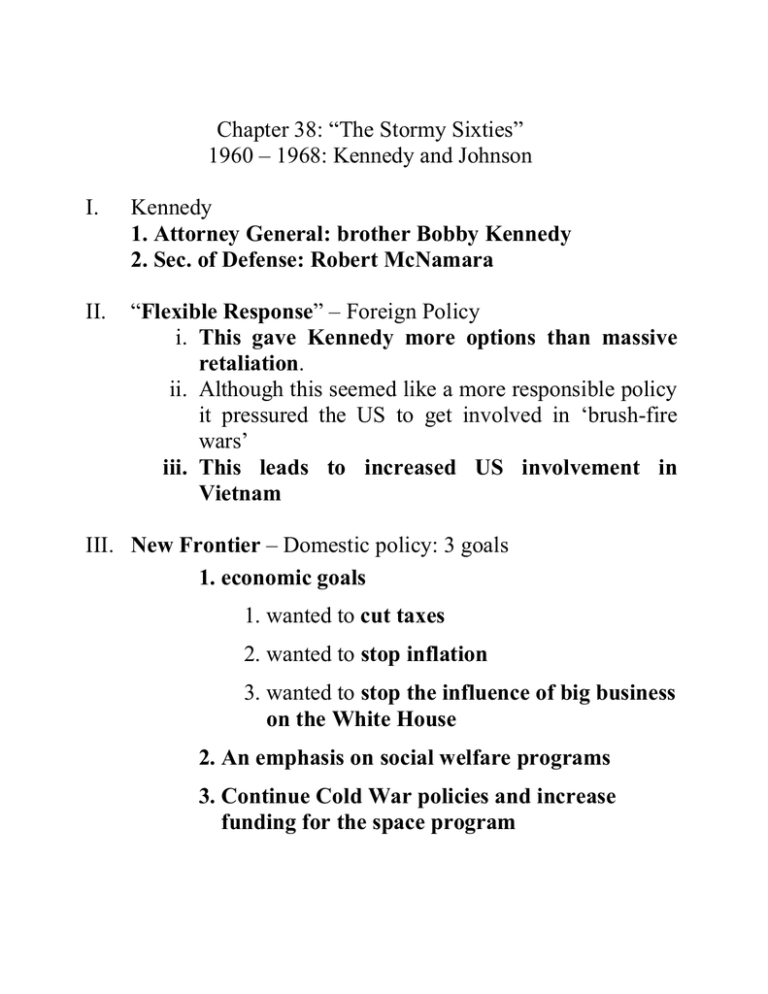
Chapter 38: “The Stormy Sixties” 1960 – 1968: Kennedy and Johnson I. Kennedy 1. Attorney General: brother Bobby Kennedy 2. Sec. of Defense: Robert McNamara II. “Flexible Response” – Foreign Policy i. This gave Kennedy more options than massive retaliation. ii. Although this seemed like a more responsible policy it pressured the US to get involved in ‘brush-fire wars’ iii. This leads to increased US involvement in Vietnam III. New Frontier – Domestic policy: 3 goals 1. economic goals 1. wanted to cut taxes 2. wanted to stop inflation 3. wanted to stop the influence of big business on the White House 2. An emphasis on social welfare programs 3. Continue Cold War policies and increase funding for the space program What Kennedy attempted and accomplished were two different things 1. Increased federal aid for education. Defeated. 2. Medical care for the elderly. Defeated during the Kennedy administration, but eventually enacted as Medicare and Medicaid under Johnson 3. Increase in the minimum wage. Passed. 4. Civil rights. No major legislation 1. During the end of his administration at the urging of his brother he does begin to speak out on behalf of civil rights legislation that gets enacted under Johnson 2. Earlier in administration he was afraid of losing Southern support of other economic bills 5. End to poverty. No. 6. Major tax cuts. Defeated. 7. Cold War goals. Yes, Kennedy's term saw both increased expenditures on defense and money for the new space program. 1. one of the major goals was to land a man on the moon by the end of the decade Kennedy vs. Steel o US steel announced that it was raising the price of steel to $6 a ton, other firms did the same o Kennedy was worried about inflation, ordered a federal investigation alleging price fixing o Kennedy called the CEO and CFO of US Steel into the Oval Office and berated them – they dropped the price, big business angry at Kennedy o In the 1950s, the West-East gap continued to widen. In West Berlin and West Germany, rebuilding boomed. In the East, food and housing were scarce. o People began "voting with their feet" – fleeing to the West. "I no longer had any reason to stay on in what I had considered my homeland," said Walter Kocher, after his East Berlin business had been seized by the government. o More than 3 million people left East Germany for a better life in the West. By 1961, the communist government knew it had to stop the exodus. o At 2 a.m. on Aug. 13, 1961, a low, barbed-wire barrier was strung between East and West Berlin. It effectively divided the city in half. Within days, workers cemented concrete blocks into a low wall through the city. o Moscow called the wall a barrier to Western Imperialism. "It pleases me tremendously," Nikita Khrushchev said. o The West Germans called it the "Wall of Shame." o Towers, guards, and dogs stood watch over a barren no man's land. o Anyone trying to escape was shot on sight. o The Berlin Wall didn't stop all East Germans. An estimated 10,000 of them tried to escape to the West. About 5,000 made it. o Some escapes were ingenious. One woman hid under the hood of a car. Two families floated over the border in a hot-air balloon as big as a four-story house o In all, 246 people died at the wall. Perhaps the best known was 18-year-old bricklayer Peter Fechter. On Aug. 17, 1962, he tried to jump the barbed wire near Checkpoint Charlie, a key border crossing between the American and Soviet sectors of Berlin. East German soldiers fired. Fechter fell. The East Germans would not allow anyone to help him as he bled to death. o By the 1980s, the Soviets were heading towards bankruptcy. In East Germany, wages were low. Homes bombed during World War II were still in ruins. Citizens lived in poverty; communist leaders lived in luxury. o But the end was near. The Soviet Union no longer could afford the Cold War - decades of military, political, and economic rivalry with the United States. Two U.S. presidents who visited the wall made strong statements in support of West Berlin and democracy. In 1963, John F. Kennedy visited. In 1987, Ronald Reagan visited Berlin and demanded: "Mr. Gorbachev, tear down this wall!" o Earlier in the 1980s, Soviet leader Mikhail Gorbachev had introduced the policies of glasnost (openness) and perestroika (democratic reform). Slowly, Eastern Europeans began to test their new freedoms. Mass protests in Dresden, Leipzig and Potsdam demanded freedom of expression, freedom of the press and freedom to travel. o Since the fall of the Berlin Wall on Nov. 9, 1989, Germany has undergone many changes leading to the reunification of East and West Germany in 1990. o 1990 In March, free elections are held in East Germany and non-communists gain control of the government. In October, East and West Germany reunite into a single nation. Berlin is declared the country's capital. IV. Cuban Confrontations 1. Kennedy’s Alliance for Progress was dubbed the Marshall Plan for Latin America, and it aimed to close the rich-poor gap in Latin American and thus stem Communism. i. However, too many Latin Americans felt that it was too little too late. 2. Bay of Pigs 3. Cuban Missile Crisis 4. In June, 1963, Kennedy spoke, urging better feelings toward the Soviets and beginning the modest policy of détente, or relaxed defense. V. The Struggle for Civil Rights 1. Freedom Riders and voting rights 2. James Meredith 3. In spring of 1963, Martin Luther King, Jr. launched a peaceful campaign against discrimination in Birmingham, Alabama, but police and authorities responded viciously, often using extremely highpressured water hoses to “hose down” the sit-in strikers. i. The entire American public watched in horror as the Black protesters were treated with such contempt, since the actions were shown on national TV. ii. Later, on June 11, 1963, JFK made a speech urging immediate action towards this “moral issue” in a passionate plea. 4. Still, more violence followed, as in September 1963, a bomb exploded in a Birmingham church, killing four Black girls who had just finished their church lesson. VI. The Killing of Kennedy 1. On November 22, 1963, while riding down a street in Dallas, Texas, JFK was shot and killed, allegedly by Lee Harvey Oswald, who was himself shot by selfproclaimed avenger Jack Ruby, and there was much controversy and scandal and conspiracy in the assassination. 2. Lyndon B. Johnson became the new president of the United States as only the fourth president to succeed an assassinated president. 3. It was only after Kennedy’s death that America realized what a charismatic, energetic, and vibrant president they had lost. VII. The LBJ Brand on the Presidency 1. Lyndon Johnson had been a senator in the 1940s and 50s, and his idol was Franklin D. Roosevelt, and he could manipulate Congress very well (through his in-your-face “Johnson treatment”); also, he was very vain and egotistical. 2. As a president, LBJ went from conservative to liberal, helping pass a Civil Rights Act of 1964, which banned all racial discrimination in most private facilities open to the public, including theaters, hospitals, and restaurants. i. Also created was the Equal Employment Opportunity Commission (EEOC), which was aimed at eliminating discriminatory hiring. 3. Johnson’s program was dubbed the “Great Society”, and it reflected its New Deal inspirations. i. Public support for the program was aroused by Michael Harrington’s The Other America, which revealed that over 20% of American suffered in poverty. VIII.Johnson Battles Goldwater in 1964 1. In 1964, LBJ was opposed by Republican Arizona senator Barry Goldwater, who attacked the federal income tax, the Social Security system, the Tennessee Valley Authority, civil rights legislation, the nuclear test-ban treaty, and the Great Society. 2. However, Johnson used the Gulf of Tonkin Incident, in which North Vietnamese ships had allegedly fired on American ships, to attack (at least partially) Vietnam, and he also got approved the Gulf of Tonkin Resolution, which gave him a virtual blank check on what he could do in affairs in Vietnam. 3. But on Election Day, Johnson won a huge landslide over Goldwater to stay president. IX. The Great Society Congress 1. Johnson’s win was also coupled by sweeping Democratic wins that enabled him to pass his Great Society programs. 2. Congress doubled the appropriation on the Office of Economic Opportunity to $2 billion and granted more than $1 billion to refurbish Appalachia, which had been stagnating. 3. Johnson also created the Department of Transportation and the Department of Housing and Urban Development (HUD), headed by Robert C. Weaver, the first Black cabinet secretary in the United States’ history. X. 4. LBJ also wanted aid to education, medical care for the elderly and indigent, immigration reform, and a new voting rights bill. i. Johnson gave money to students, not schools, thus avoiding the separation of church and state by not technically giving money to Christian schools. ii. In 1965, new programs called Medicare and Medicaid were installed, which have certain rights to the elderly in terms of medicine and health maintenance. iii. The Immigration and Nationality Act of 1965 abolished the “national origin” quota and doubled the number of immigrants allowed to enter the U.S. annually, to 290,000. 5. An antipoverty program called Project Head Start improved the performance of the underprivileged in education. The Black Revolution Explodes 1. Johnson’s Voting Rights Act of 1965 attacked racial discrimination at the polls. 2. The 24th Amendment eliminated poll taxes, and in the “freedom summer” of 1964, both Blacks and White students joined to combat discrimination and racism. i. However, in June of 1964, a Black and two White civil rights workers were found murdered, and 21 White Mississippians were arrested for the murders, but the all-White jury refused to convict the suspects. ii. Also, an integrated “Mississippi Freedom Democratic Party” was denied its seat. 3. Early in 1965, Martin Luther King, Jr. resumed a voterregistration campaign in Selma, Alabama, but was assaulted with tear gas by state troopers. i. LBJ’s response the stunned American people sped more reform. XI. Black Power 1. 1965 began a time of violent Black protests, such as the one in the Watts area of LA, as Black leaders mocking Martin Luther King, Jr. like Malcolm X (born Malcolm Little), who was inspired by the Nation of Islam and its founder, Elijah Muhammed, urged action now, even if it required violence, but he was killed in 1965. 2. The Black Panther openly brandished weapons in Oakland, California. 3. Trinidad-born Stokley Carmichael led the urged an abandonment of peaceful demonstrations. 4. Black power became a rallying cry by Blacks seeking more rights, but just as they were getting them, more riots broke out, and nervous Whites threatened with retaliation. 5. Tragically, on April 4, 1968, Martin Luther King, Jr. was assassinated. i. Quietly, though, thousands of Blacks registered to vote and went into integrated classrooms, and they slowly built themselves into a political power group. XII. Combating Communism in Two Hemispheres 1. Johnson sent men to put down a supposedly Communist coup in the Dominican Republic and was denounced as over-anxious and too hyper. 2. In Vietnam, though, he slowly sent more and more U.S. men to fight the war, and the South Vietnamese became spectators in their own war. Meanwhile, more and more Americans died. 3. By 1968, he had sent more than half a million troops to Asia, and was pouring in $30 billion annually, yet the end was nowhere in sight. XIII.Vietnam Vexations 1. America was floundering in Vietnam and was being condemned for its actions there, and French leader Charles de Gaulle also ordered NATO off French soil in 1966. 2. In the Six-Day War, Israel stunned the world by defeating Egypt (and its Soviet backers) and gaining new territory in the Sinai Peninsula, the Golan Heights, the Gaza Strip, and the West Bank of the Jordan River, including Jerusalem. 3. Meanwhile, numerous protests in America went against the Vietnam War and the draft. i. Opposition was headed by the influential Senate Committee of Foreign Relations, headed by Senator William Fullbright of Arkansas. ii. “Doves” (peace lovers) and “war hawks” (war supporters) clashed. 4. Both sides (the U.S. and North Vietnam) did try to have intervals in bombings, but they merely used those as excuses to funnel more troops into the area. 5. Johnson also ordered the CIA to spy on domestic antiwar activists, and he encouraged the FBI to use its counterintelligence program (“Cointelpro”) against the peace movement. 6. More and more, America was trapped in the awful Vietnam War, and it couldn’t get out, thus feeding more and more hatred and resentment to the American public. XIV. Vietnam Topples Johnson 1. Johnson was personally suffering at the American casualties, as he wept as he signed condolence letters and even prayed with Catholic monks in a nearby church—at night, secretly, and the fact that North Vietnam had almost taken over Saigon in a blistering offensive during Tet, the Vietnamese new year, didn’t help either. 2. Johnson also saw a challenge for the Democratic ticket from Eugene McCarthy and Robert Kennedy, and the nation, as well as the Democratic Party, was starting to be split by Vietnam. i. LBJ refused to sign an order for more troops to Vietnam. 3. Then, on March 31, 1968, Johnson declared that he would stop sending in troops to Vietnam and that he would not run in 1968, shocking America. XV. The Presidential Sweepstakes of 1968 1. On June 5, 1968, Robert Kennedy was shot fatally, and the Democratic ticket went to Hubert Humphrey, Johnson’s “heir.” 2. The Republicans responded with Richard Nixon, paired with Spiro Agnew, and there was also a third-party candidate: George C. Wallace, former governor of Alabama, a racist who wanted to bomb the Vietnamese to death (what a radical!). XVI. Victory for Nixon 1. Nixon won a nail-biter, and Wallace didn’t do that badly either, though worse than expected. 2. A minority president, he owed his presidency to protests over the war, the unfair draft, crime, and rioting. XVII. The Obituary of Lyndon Johnson 1. Poor Lyndon Johnson returned to his Texas ranch and died there in 1973. 2. He had committed America into Vietnam with noble intentions, and he really wasn’t a bad guy, but he was stuck in a time when he was damned if he did and damned if he didn’t. XVIII. The Cultural Upheaval of the 1960s 1. In the 60s, the youth of America experimented with sex, drugs, and defiance. 2. They protested a lot against conventional wisdom and beliefs. 3. Such poets like Allen Ginsberg and novelists like Jack Kerouac voiced these opinions. 4. Movies like Rebel without a Cause also showed this belief. 5. At the UC Berkeley, in 1964, a so-called Free Speech Movement began. i. Kids tried drugs, “did their own thing” in new institutions, and rejected patriotism. 6. In 1948, Indiana University “sexologist” Dr. Alfred Kinsey had published Sexual Behavior in the Human Male, and had followed that book five years later with a female version, and his findings about the incidence of premarital sex and adultery were very controversial. i. He also estimated that 10% of all American males were gay. ii. The Manhattan Society, founded in LA in 1951, pioneered gay rights. 7. Students for a Democratic Society, once against war, later spawned an underground terrorist group called the Weathermen. 8. The upheavals of the 1960s can largely be attributed to the three P’s: the youthful population bulge, the protest against racism and the Vietnam War, and the apparent permanence of prosperity, but as the 1970s rolled around, this prosperity gave way to stagnation. 9. However, the “counterculture” of the youths of the 1960s did significantly weaken existing values, ideas, and beliefs.
